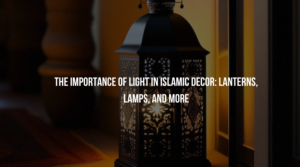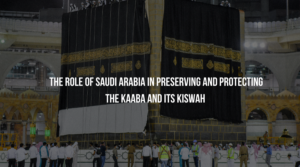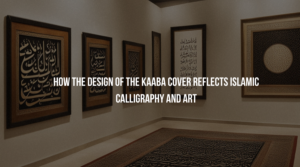In the heart of the sacred city of Mecca stands a symbol of unity, devotion, and history. The Kaaba, a cube-shaped building at the center of the Masjid al-Haram, is the most revered and holiest site in Islam. Pilgrims from all corners of the globe make the sacred journey to the Kaaba each year during Hajj, while millions more face it in prayer, no matter where they are. But while the Kaaba itself is a significant religious icon, the Kiswa, the black silk and gold curtain that drapes over it, carries its own powerful and silent narratives.
The word “Kiswa” in Arabic means “covering,” and the Kaaba’s Kiswa serves not only as a physical covering but also as a symbolic one. This unassuming yet intricately woven black cloth is replaced each year on the 9th day of Dhu al-Hijjah, the month of Hajj, in a sacred ritual that has been ongoing for centuries. The Kaaba Cover, as a religious artifact, is more than just a piece of fabric; it encapsulates history, devotion, craftsmanship, and reverence.
A History Woven in Threads
The Kaaba Cover has a history that spans over a thousand years. It is more than a mere piece of black silk; it is a living testimony to the passage of time and the changes the world has witnessed. The tradition of covering the Kaaba dates back to the pre-Islamic era when Mecca was a bustling center for trade and pilgrimage, a sacred site for various Arabian tribes.
The earliest coverings were made from simple, locally sourced materials. As Islam began to flourish and the Kaaba gained prominence, the tradition of covering it took on greater significance. Throughout history, different dynasties and rulers contributed to the tradition. Caliphs, sultans, and kings from various Islamic empires, including the Abbasids, Fatimids, Mamluks, and Ottomans, all played a part in adorning the Kaaba with the finest Kaaba Cover.
The Kaaba Cover went through transformations in terms of fabric, design, and craftsmanship. Originally, it was a simple cloth made from locally woven fabric. However, over time, the Kaaba Cover evolved into a masterpiece of Islamic art. The black silk was meticulously woven, and the golden calligraphy adorning it became more intricate.
Each Kaaba Cover is a testament to the collective efforts of weavers, artisans, and craftsmen who have dedicated their skills to this sacred task. The art of crafting the Kaaba Cover has been passed down through generations, preserving the rich tradition of Islamic calligraphy and textile work.
Symbolism and Spiritual Significance
The Kiswa is not merely a decorative covering for the Kaaba. It is symbolic in many ways, representing deeper spiritual and cultural values. The most obvious aspect of its symbolism is the color: black. Black is considered the color of modesty, humility, and simplicity in Islam. The Kiswa, with its deep black hue, reflects the humility of all those who visit the Kaaba, reminding them that in the eyes of God, all are equal.
Another important aspect is the gold calligraphy that adorns the kaaba kiswa. The Quranic verses and Islamic inscriptions are woven into the fabric with intricate precision. This is a testament to the importance of the written word in Islam and the value placed on knowledge and spirituality. The verses from the Quran are a reminder of the divine presence and the unity of God.
The Kiswa also represents the unity of the Muslim community. People from all walks of life, regardless of their nationality, ethnicity, or social status, gather at the Kaaba during Hajj. The Kiswa serves as a unifying symbol, reminding pilgrims of the shared faith that binds them together.
The Annual Changing of the Kaaba Kiswa
The process of changing the kaaba kiswa is a sacred and meticulously planned event that takes place each year. The new Kiswah is prepared months in advance, and it is not a task taken lightly. The new kaaba kiswa is brought to the Masjid al-Haram in a grand procession, accompanied by prayers and recitations from the Quran.
As the old kiswah is carefully removed, it is not discarded; instead, it is cut into smaller pieces and distributed to dignitaries and institutions as a symbol of blessing. The process of changing the kiswah is a reminder of the passage of time and the renewal of faith. It is a tradition that carries immense spiritual significance for Muslims worldwide.
Contemporary Challenges and Preservation
In recent times, there have been challenges to the traditional Kiswa-making process. The materials used, including the silk and gold, have become more expensive and difficult to source. Additionally, there is a growing concern for environmental sustainability and ethical practices in the textile industry. As a result, there have been efforts to address these challenges by using more sustainable materials and practices while preserving the traditional craftsmanship.
The Kiswa is a reminder of the intricate interplay between tradition and innovation, spirituality, and sustainability. Efforts are being made to ensure that the kiswah remains a symbol of reverence and respect for centuries to come, while also addressing contemporary concerns.
In conclusion, the Kaaba Kiswa is not just a piece of fabric; it is a silent narrator of the history of Islam and the devotion of countless believers. It is a symbol of unity, humility, and faith that transcends national and cultural boundaries. The kaaba kiswa represents the living history of the Islamic world, where tradition and spirituality are woven together into a beautiful tapestry of devotion. As each year brings a new Kaaba Cover, it is a testament to the enduring nature of faith and the silent narratives that continue to be etched into its fibers, telling the story of Islam and the unwavering devotion of its followers.




